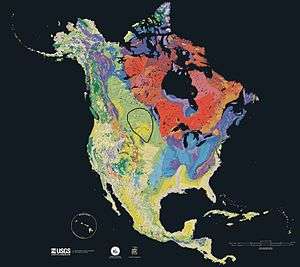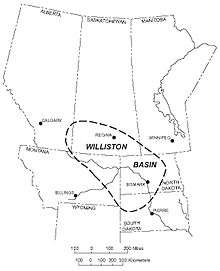Williston Basin


The Williston Basin is a large intracratonic sedimentary basin in eastern Montana, western North Dakota, South Dakota, and southern Saskatchewan, that is known for its rich deposits of petroleum and potash. The basin is a geologic structural basin but not a topographic depression; it is transected by the Missouri River. The oval-shaped depression extends approximately 475 miles (764 km) north-south and 300 miles (480 km) east-west.
The Williston Basin lies above an ancient Precambrian geologic basement feature, the Trans-Hudson Orogenic Belt that developed in this area about 1.8-1.9 billion years ago, and that created a weak zone that later led to sagging to produce the basin.[1] The Precambrian basement rocks in the center of the basin beneath the city of Williston, North Dakota lie about 16,000 feet (4,900 m) below the surface.

Deposition of sediments began in the Williston area during Cambrian time, but subsidence and basin filling were most intense during the Ordovician, Silurian, and Devonian Periods, when thick accumulations of limestone and dolomite, with lesser thicknesses of sandstones, siltsones, shales, and evaporites were laid down. Subsidence continued on a reduced scale into the Mississippian and was largely ended by Pennsylvanian time. Regional subsidence returned during the Mesozoic Era, although total sediment thicknesses were much less than during the Paleozoic. Near the end of the Cretaceous, tectonic activity during the Laramide Orogeny rejuvenated several basement structures in the Williston Basin to produce anticlines that serve as oil traps today.[2]
Natural resources
Petroleum

The long history of sedimentary deposition in the Williston Basin included deposition of rocks well suited to serve as hydrocarbon source and reservoir rocks. The basin's oil and gas fields are found in a wide range of geologic ages, as indicated by the generalized stratigraphic column.[4]
Oil was first found in the Williston Basin along the Cedar Creek Anticline in southeastern Montana, in the 1920s and 1930s.[5] The basin did not become a major oil province until the 1950s when large fields were discovered in North Dakota. Amerada, the largest independent oil firm, began the search in 1946. After four years of testing and mapping they started drilling at a promising lease 30 miles north-east of Williston, ND and on April 4, 1951 found a large field of oil underground. Immediately other oil firms rushed in to buy up leases on farm land to explore for oil and by 1954 80% of the possible oil producing areas were under lease. Shell at that time had leases over 8 million acres. Many local farmers and area speculators became instant millionaires, leasing land at an average of $25 an acre and then selling those leases back at a much higher cost per acre.[6] Production peaked in 1986, but in the early 2000s significant increases in production began because of application of horizontal drilling techniques, especially in the Bakken Formation.[7]
Cumulative basin production totals about 3.8 billion barrels (600,000,000 m3) of oil[8] and 470 billion cubic feet (1.3×1010 m3) of natural gas.[9] The largest oil fields are listed in the following table, showing estimated ultimate recoveries.[4]
| Field Name | Discovery Year | Est. ult. oil (million barrels) |
Est. ult. gas (billion cubic feet) |
Est. ult. nat. gas liquids (million barrels) |
|---|---|---|---|---|
| Elm Coulee, Richland Co.,MT[10] | 2000 | 270 | ||
| Beaver Lodge, N. Dak. | 1951 | 130 | 115 | 47 |
| Pine, Mont. | 1952 | 127 | 20 | |
| Pennel, Mont. | 1955 | 115 | ||
| Cabin Creek, Mont. | 1953 | 115 | ||
| Little Knife, N. Dak. | 1977 | 96 | 120 | 15 |
| Tioga, N. Dak. | 1952 | 77 | 43 | 17 |
| Blue Buttes, N. Dak. | 1955 | 53 | 36 | 5 |
| Charlson, N. Dak. | 1952 | 52 | 100 | 11 |
Potash
Potash produced from the Williston Basin makes Canada the world's leading producer of that commodity.[11] Major potash-producing companies include the Potash Corporation of Saskatchewan.
Coal
The Williston Basin holds large coal deposits, primarily in the Fort Union Formation of mostly Paleogene age.
Impact craters
Several confirmed impact craters are located in Williston Basin such as Viewfield, Red Wing Creek, and Eagle Butte while the Dumas and Hartney craters are still unconfirmed.
See also
References
- ↑ Gibson, R.I., 1995, Basement tectonics and hydrocarbon production in the Williston Basin: An interpretive overview: 7th Int'l. Williston Basin Symposium, 1995 Guidebook, p. 3-11
- ↑ Geologic Atlas of the Rocky Mountain Region, Rocky Mountain Association of Geologists, Denver, CO, 1972: p. 81-85, 88-89, 94-97, 168, 184
- ↑ Oil production chart source
- 1 2 Peterson, J., Williston Basin Province, in U. S. Geological Survey 1995 National Assessment of United States Oil and Gas Resources, Digital Data Series DDS-30, Release 2, CD-ROM
- ↑ Oil Exploration History of Williston Basin
- ↑ "Buffalo, Cattle and Now Oil." Popular Mechanics, October 1954, pp. 106-109/262.
- ↑ Diagenesis and Fracture Development in the Bakken Formation, Williston Basin: Implications for Reservoir Quality in the Middle Member, by Janet K. Pitman, Leigh C. Price, and Julie A. LeFever, U.S. Geological Survey Professional Paper 1653, 2001
- ↑ Cumulative oil production
- ↑ Cumulative gas production
- ↑ Elm Coulee Field
- ↑ S.M. Jasinski, "Potash," Mining Engineering, June 2010, p.69-70.
Coordinates: 49°N 104°W / 49°N 104°W